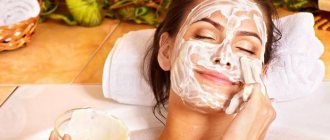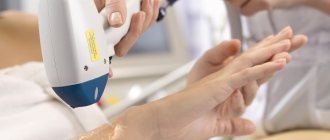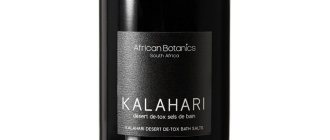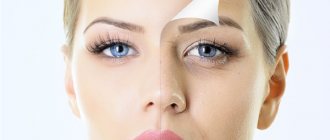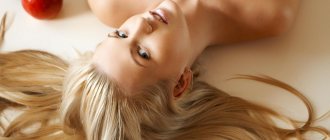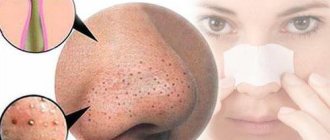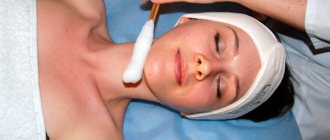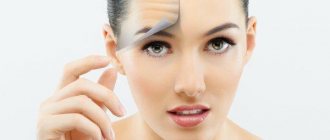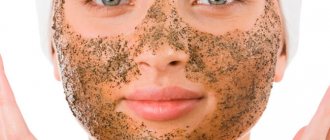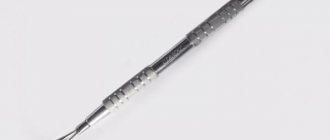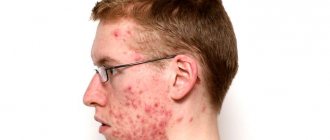From this article you will learn:
- how professional microdermabrasion is performed in a salon,
- Microdermabrasion at home is the best remedy.
Microdermabrasion is a non-surgical procedure that removes the surface layer of skin made up of dead cells. Essentially, this is mechanical peeling of the skin using abrasives. In salons, the procedure is carried out using a special apparatus, from the tip of which a stream of air containing abrasive crystals is released under pressure (Fig. 1-3).
Typically, the abrasives used are aluminum oxide, magnesium oxide, sodium bicarbonate or sodium chloride crystals. The collision of the abrasive with the surface of the skin leads to the sloughing of dead skin cells. Patients often compare their sensations during the procedure to what they feel when a cat licks the face with its rough tongue.
Microdermabrasion 100% copies the Air Flow method in dentistry, which is used to clean teeth from pigmented plaque. This method uses a water-air spray containing soda crystals. As a result, teeth become snow-white.
Important: since human skin recovers in approximately 30-day intervals, you need to understand that skin improvement after professional microdermabrasion in a salon will be temporary. To maintain the results, you must repeat the procedure every 2-4 weeks.
Diamond microdermabrasion of the face: reviews
Removal of the superficial dead layer of skin can be carried out not only with the help of a stream of air with abrasive particles. Recently, devices have appeared whose working nozzles have embedded edges of artificial diamonds on their surface (Fig. 4-5). The doctor simply moves this attachment over the patient’s skin, sanding off the surface layer of skin, and a vacuum suction sucks up the detached skin particles.
The only advantage of this method is that it is safer for use in the patient's eyes and lips, because... there is no air jet with abrasive crystals that can injure the cornea of the eyes or the red border of the lips. But even with the standard technique, such complications usually do not arise. Diamond microdermabrasion is often called diamond facial peeling by patients.
Differences between microdermabrasion and dermabrasion -
Microdermabrasion and dermabrasion are cosmetological methods that are based on mechanical grinding of the skin using abrasive elements. These methods differ only in the depth of skin resurfacing. Microdermabrasion involves removing only the most superficial layer of skin, consisting of dead epidermal cells.
But with dermabrasion, the depth of resurfacing is much greater, which implies subsequent more significant changes in the skin. The dermabrasion method is more radical, requires more qualified doctor and should, as a rule, be performed only by dermatologists or plastic surgeons.
Microdermabrasion: indications
Because This procedure does not cause any noticeable damage to the skin - it is completely safe for most people. Although the face is the most common area for microdermabrasion, this method can be used on absolutely any area of the skin: neck, chest, back, and arms. The skin can become noticeably smoother even after one treatment, and it begins to better absorb moisturizers (creams, oils).
Microdermabrasion is generally recommended for people over 12 years of age and for adults under 65 years of age. Age restrictions are conditional, because People over 65 have a higher risk of bruising and skin abrasions, and people under 12 can receive treatment under the supervision of a dermatologist.
Indications are –
- photoaging of the skin as a result of exposure to sunlight,
- reducing the depth of fine wrinkles,
- age spots,
- in complex therapy of acne (acne),
- if you have superficial acne scars,
- the need to improve complexion (especially for people with yellowish skin).
For acne - dermatologists quite often use microdermabrasion for acne to help clean out deep pores and improve skin condition. Moreover, when treating acne, dermatologists usually use microdermabrasion in combination with superficial chemical peels based on glycolic or acetyl salicylic acids. This combination significantly speeds up recovery (Fig. 9-11).
For melasma - yes, microdermabrasion can be useful in the treatment of melasma and other types of hyperpigmentation (24stoma.ru). Optimal treatment in such situations would include microdermabrasion (every 2-4 weeks) combined with glycolic acid peels (once weekly). The general course of treatment is 6 weeks. In addition, the use of lightening creams (such as hydroquinone 4%) is recommended, as is the daily use of sunscreen.
Microdermabrasion: Before and After photos
mechanical face resurfacing
Karina Musaeva, chief physician of the Laser Lounge Clinic, 29 years old
About daily care:
“I am a perfectionist and a beautyaholic: I love trying different new products. But my preferences are American professional cosmeceuticals. It, unlike the European one, is more straightforward: it contains the maximum permissible concentrate of active ingredients and gives a good result in a short time, i.e. it, in my opinion, is more in line with the rhythm of the metropolis, while European cosmetics are more inclined to the concept of “spa” and “eco”.
For me, cleansing the skin comes first. This is the foundation of healthy and youthful skin. I recommend acid cleansing to everyone. Why? Chemical cleansing is much more effective than mechanical cleansing (scrubs), because... acids not only remove dead epidermal cells, deeply cleansing pores and narrowing them, but also give the cells a signal for renewal. The skin begins to glow thanks to improved microrelief. Then I love vitamin C serums in the L form. Regular ascorbic acid causes allergic reactions and irritation. In L-shape - never! Therefore, serums with L-ascorbic acid really rejuvenate.
I don't use foundation because... That is unnecessary. I believe that cosmetology is, first of all, about the quality of the skin (this is my “fad”), and I am sure that any skin can become ideal with the right care system. When it comes to makeup, I love red lipstick with a moisturizing effect and lengthening mascara. I also can’t imagine myself without a niche scent.”
About your favorite cosmetics:
“I love IS Clinical serums - Active Serum, Hydra Cool, Cosmedix pomegranate chirally correct peeling, Orofluido hair care - natural oils are very necessary for my hair!”
About favorite procedures:
“Of the procedures, I like elos rejuvenation using the Elos Plus device, gas-liquid peeling Jet Peel (it combines 5 procedures in one - cleansing, peeling, oxygenation, needle-free mesotherapy, massage). For body care I use the VIP Line device: 20 min. it equals 2.5 hours of running, and in one session you can get rid of 3-5 cm from the waist.”
I want to try:
“Like many women, the lower third of my face bothers me. I would like to try Silhouette threads. This is a non-surgical lifting technology using a unique system of threads with fixing elements - microcones made of absorbable material. Microcones reliably fix the threads subcutaneously, and their tension ensures the return of soft tissues to the position as at a young age. Gradually dissolving, the cones become overgrown with collagen fibers, which finally fix the tissue, securing the result.”
Elena Levchuk, cosmetologist, dermatovenerologist of medical and cosmetology department, 33 years old
About daily care:
“I try to eat right, stay hydrated (at least 1.5 liters of water per day) and get enough sleep. I often repeat Coco Chanel’s phrase to myself and my patients: “Your face at 20 is given to you by nature, what it will be like at 50 depends on you,” so I am never lazy in taking care of myself. Every morning and evening I carry out all stages of cleansing: makeup removal, moisturizing, nutrition, skin protection. I apply all cosmetics strictly along the massage lines so as not to stretch the skin.”
About your favorite cosmetics:
“I prefer to change brands seasonally so that I don’t get used to it. Now I use Dermaheal cosmetics. My arsenal includes Foaming Cleanser, Total care Skin Solution toner, Vitalizing Serum, Vitalizing Eye Tension Gel, Vitalizing Mask Pack and color corrector cream with SPF 30 CC Cream Tan Beige. This is an anti-aging system with biomimetic peptides that is perfectly absorbed. The effect of using this brand really surprised me; the hydration and protection are so long-lasting that there was no discomfort in the summer. At the same time, I do not forget that age-related skin changes require a more profound effect at the level of sleep using injection and hardware techniques. I can’t see myself and my treatments without regular cosmetic procedures.”
About favorite procedures:
“I do all facial procedures exclusively myself: botulinum therapy, biorevitalization, contouring, peelings.”
I want to try:
“At the moment, I have found my program for facial rejuvenation and am trying to stick to it. I treat new products with caution, studying the mechanism of action for a long time before trying it on myself and offering it to my clients.”
Elena Mishchenko, dermatocosmetologist at the AIDA medical cosmetology clinic, 32 years old
About daily care:
“Cleansing and toning the skin 2 times a day (morning and evening), then applying a cream (specifically, day or night) and a universal cream for the area around the eyes. In addition, I do gommage twice a week (after the first I apply a cleansing mask, after the second I apply a moisturizing mask). I also consider it very important to prevent aging of the skin of the neck and décolleté - I also apply a special cream for this area daily, both in the morning and in the evening.”
About your favorite cosmetics:
“I like cosmetics from the French beauty house Carita. I see that the products work both on my skin and on the skin of my patients. My favorite product is Carita's Creme Rexlexion evens out skin tone (it gives an instant glow and makes you feel completely comfortable). I’m also a fan of the Carita Spa Mask based on the water of the Polynesian lagoons (Bain des lagons) - I use it once a week to intensively moisturize the skin. What’s especially nice is that if you have dry skin, the mask can be used instead of a night cream.”
About favorite procedures:
“I won’t single out one thing, because... I'm always trying something new."
I want to try:
“I have repeatedly performed plasmolifting procedures on patients and have always seen such a good effect, so I planned to take a course this year, especially since it is small - you only need to do 4 procedures once every 2 weeks.”
Daria Vladimirovna Mukha, dermatologist, cosmetologist at the Virsheba clinic, 29 years old
About daily care:
“Every day I wash my face with gel for combination skin, then apply a pigment tightening toner, day cream, and eye cream. In the evening, everything is the same, only using night cream. Two or three times a week I do gommage or apply peeling cream.”
About your favorite cosmetics:
“I love the German cosmeceuticals Farfor Princess, namely the Porcelain Face Mask for its pigment-tightening matting properties, the Purifying Gel for washing, because it does not dry out the skin, gently cleanses and gives a feeling of freshness, Porcelain body secret 1 - a cream to fight cellulite for pleasant texture, absorbency, smell and active substances that really help reduce the visible appearance of cellulite. I also love the German cosmeceuticals Koko dermoviduals, namely augengel for the skin around the eyes for its light texture, lymphatic drainage effect and lack of pilling when further applying cosmetics. I love the Belgian Nannic serums, especially Lifting and Flaccid skin for their lamellar base that integrates into the epidermis and for the visible results on patients after a week of use. From the same Nannic brand, I love Venatrix face cream fluid, which is suitable for skin with couperosis and rosacea, and alginate masks from the same brand for ease of application and visible results on patients.”
About favorite procedures:
“The procedures I always do are elos rejuvenation, RF lifting, RF resurfacing, Vela Shape for the body.”
I want to try:
“In the fall I plan to do elos rejuvenation and plasma lifting - in combination they give a good visible result.”
Rimma Moisenko, Ph.D., dermatocosmetologist, creator of the original weight loss method, doctor of the highest category, head of the Rimmarita Center for Aesthetic Medicine, 48 years old
About daily care: "
From my point of view, external beauty is determined by the internal component of a person, his soul. It has been noticed that a generous, kind, sympathetic person is always beautiful, despite his primary genetic data. For me, my skin and my body have always been significant. First there was classic care, compliance with the necessary hygiene rules and a classic moisturizer that a young girl needs. At 36, of course, I already had Botox; after 40, I had contour plastic surgery.
For good condition and external beauty, you need a large amount of water consumed, because this is a healthy color and turgor of the skin. Controlling a stable weight is important, as large changes lead to sagging skin. Physical activity is required to keep muscles toned. For an older woman, at least eight hours of sleep and dietary restrictions are extremely important every day. Fresh air, travel, walks, and life outside the city on weekends are also important components of beauty.”
About your favorite cosmetics:
“For the past 13 years I have been using products from the French manufacturer Biologique Recherche. I use all the lines in the classic sequence of application. At the moment, over the past three years, I have been in love with the line of Japanese manufacturers Dr. Proens is the quality of the skin, its radiance and protection. I simply cannot allow cells to age the way nature intended. Therefore, one should go against nature, because... I need this not only because of the demands of my profession, it is important for my inner state.”
About favorite procedures:
“With a certain regularity, in cycles, I do biorevitalization, bioreinforcement, plasma lifting. I do my morning and evening home care without fail.”
I want to try:
“By nature, I am a researcher, and therefore I try almost everything new that appears on the market for myself. And for me this is very important - otherwise how can I tell my patients about various new products? And do I have the right to recommend something I’m not sure about? I haven’t tried carboxy therapy or mesothreads with bells yet; interesting are the new peptide complexes developed by Korean specialists and offered by the Fiji company. All procedures related to preserving hair and improving its quality are also very relevant for me.”
Microdermabrasion: contraindications
Microdermabrasion - reviews, as a rule, have only positive ones. In addition, this is an extremely safe treatment method. But the possible risks of alternative treatment methods (dermabrasion, laser resurfacing, peeling) are much higher than microdermabrasion.
Contraindications –
- if you are currently taking aspirin or blood thinners.
- Patients using the drug Isotretinoin or who have taken it within the previous 6-12 months – microdermabrasion is contraindicated due to the increased risk of scarring.
Possible TEMPORARY side effects of microdermabrasion:
- skin redness,
- small abrasions (Fig. 12),
- skin sensitivity,
- the appearance of spider veins,
- exacerbation of herpes in the lip area,
- minor bruising (especially if you are taking aspirin or other blood thinners),
- Overly aggressive microdermabrasion can lead to the development of inflammation in certain areas of the skin, and as a result, to areas of inflammatory hyperpigmentation.
How to behave after the procedure -
Most people can return to their normal activities immediately after the procedure. Makeup and non-irritating creams can usually be applied immediately after the procedure. Research has shown that microdermabrasion can temporarily make it easier for substances to penetrate the skin by increasing its permeability. To hydrate and plump the skin after microdermabrasion, it is best to use creams and serums with hyaluronic acid.
Important: remember that after the procedure you must use a moisturizer with sun protection (preferably with SPF 30). This is necessary because UV radiation can cause uneven skin tone.
Microdermabrasion Alternatives –
Due to the fact that the procedure involves only the most superficial layer of the skin, microdermabrasion has the following advantages: firstly, a low risk of complications and side effects, and secondly, rapid skin restoration compared to less gentle methods of skin resurfacing. However, you need to understand that the more gentle the procedure, the less potential benefit it can bring.
Alternatives to microdermabrasion are:
- dermabrasion,
- peeling (chemical),
- skin resurfacing with fractional laser.
Types of procedures: salon offers
Professional cosmetologists offer different peeling options: mechanical, cosmetic, fractional. It is precise to categorize procedures precisely, since the same manipulation can be performed in different ways.
One of the most popular salon procedures is microdermabrasion. Mechanical grinding is carried out using a special apparatus with a variety of attachments. Under the influence of a vacuum, microscopic crystals of aluminum oxide are directed to the problem area, removing impurities and dead cells layer by layer. They gently polish the skin without causing irritation or damage.
Microdermabrasion is recommended for problematic skin prone to inflammation. It perfectly cleanses contaminated pores, evens out the surface, and stimulates natural cell renewal. The skin becomes more elastic and soft, it accepts skincare cosmetics better. The procedure is practically painless, does not cause side effects and has a minimum of contraindications.
Moisturizing, nourishing, restorative masks, creams and serums will help speed up recovery. It is advisable to use products from professional series, which are recommended by a cosmetologist.
The number of sessions is calculated individually. The cosmetologist can prescribe 3, 5 or even 7 polishings. For noticeable defects, long-term treatment is necessary, since the skin must have time to recover after each procedure.
A more gentle option is diamond grinding. After the procedure, the face turns red, but restores its normal color within a few hours. The next day the patient can go to work or a date, the skin will look great. Only diamond-coated nozzles can provide this effect. They can be used to polish even particularly sensitive eyelid skin without causing harm to it. The procedure is painless, in some cases there is slight itching or tingling, which quickly passes.
Acid-based cosmetic peeling can be done both in the salon and at home.
During grinding, diamond-coated attachments carefully remove dead skin particles, which are instantly drawn in by vacuum. The effect is noticeable after the first procedure. Pores are cleansed and narrowed, minor inflammations and wrinkles disappear, the face becomes fresher and smoother. Diamond peeling is recommended for those with dry and sensitive skin, as well as women suffering from uneven pigmentation and fine wrinkles.
For severe acne and scars left after acne, laser resurfacing is recommended. This is a more complex procedure performed under local anesthesia. Preparation with the application of special preparations will help prevent infection. Preparing the skin begins a month before laser peeling.
During the procedure, a laser beam is directed at areas of the skin, quickly removing the top layer of dead skin cells. The effectiveness of the manipulation depends on the skill of the cosmetologist. Burns are excluded - the beam acts on the epidermis for a fraction of a second, this time is quite enough to smooth out the relief. The procedure allows you to remove noticeable spots, post-acne, unevenness and wrinkles. The rays stimulate the production of collagen fibers and significantly increase skin density.
After laser resurfacing, the face recovers in about 2 weeks. In the first days, the skin is smeared with a special soothing ointment. It is necessary to avoid direct sunlight, and when going outside, protect your face with high SPF creams. The skin may remain pink for 1-2 months, then it will return to its normal color. The effect of the procedure lasts for at least a year.
Diamond grinding is indispensable for women with sensitive or dry skin.
Indications for facial microdermabrasion
Cosmetologists recommend that patients opt for facial microdermabrasion if they have the following indications:
- enlarged pores;
- acne;
- expression wrinkles of varying intensity;
- dark spots;
- uneven skin texture;
- collagen and elastin deficiency.
Depending on the condition of the patient’s skin at the time of contacting the clinic, a history of chronic diseases, as well as the desired result, the specialist selects the number of sessions necessary for complete restoration. As a rule, 5-7 procedures are enough. The duration of one session is 20-40 minutes. The procedure is painless, but patients with increased sensitivity can discuss the possibility of anesthesia with a cosmetologist in advance.
Contraindications
The procedure is not carried out in the presence of purulent acne, fresh lesions, or inflamed areas. First you need to wait until the acute phase of the process passes. You can speed up preparation with the help of cosmetic procedures, so the best choice in this case would be a comprehensive treatment method.
After microdermabrasion, you may experience swelling of the skin, a burning sensation, tingling and itching caused by the growth of new layers. But in most cases, all these phenomena pass quite quickly.
However, if you need to look “dressy” at any event, it is advisable to carry out microdermabrasion at least two weeks before it. Then the skin will be completely restored and can be demonstrated in all its renewed beauty.
What is microdermabrasion?
Skin resurfacing using attachments containing diamond chips is called facial microdermabrasion. The procedure was first used by French cosmetologists, which is why this type of dermabrasion is sometimes called Parisian peeling.
The manipulation has a visible rejuvenating effect and smoothes the skin well. After a specialist-recommended recovery course, the patient may notice the following positive changes:
- improvement of complexion;
- resorption of age spots;
- disappearance of scars and cicatrices resulting from acne;
- oval facelift.
Due to the mechanical impact of pronounced intensity, blood and lymph flow accelerates in the area affected by the device nozzle, and increased production of elastin and collagen begins. Thanks to increased cell division, new connective tissue is produced, characterized by elasticity.
With the help of microdermabrasion, the rejuvenating effect is achieved by accelerating natural metabolic processes, without the use of hyaluronic acid and other foreign active enzymes.
Chemical peeling recipes
To carry out chemical peeling at home, specialized mixtures are sold, which must be prepared according to the instructions shortly before the procedure. But you can also use natural acids found in fruits to polish your skin.
Pineapple peeling
To prepare one of the peeling compositions at home, you need to mix papaya (100 g), pineapple (200 g) and honey (2 tbsp.) in a blender.
Then the mixture is applied to the face and left for no more than 5 minutes. You need to wash off the mask with cool water. After the procedure, you should not use decorative cosmetics for 24 hours, or touch your face with your fingers.
Lemon peeling
Citric acid is an excellent remedy for tightening enlarged skin pores. It is able to rid the skin of age spots and has matting properties.
You can get a lemon peeling product at home by mixing lemon juice and vegetable oil. The prepared mask is applied to the face. After 5 minutes, the lemon mixture is washed off with warm water.
Strawberry peeling
Peeled, crushed sour strawberries are another suitable remedy for acid peeling at home. The strawberry mixture is applied to problem areas, and after 4-5 minutes it is washed off the face with water.
Thus, some types of face resurfacing can be practiced at home, using regular products or mixtures purchased in specialized stores. However, home treatments will not help cope with serious skin defects - in such cases, it is better to visit a beauty salon and undergo a course of cosmetic procedures from a qualified specialist.
How does skin resurfacing differ from regular peeling?
In principle, there is a lot in common between these two procedures. If you want to study the freely available materials on them, you can see that some authors quite freely use the concept of “peeling” as a synonym for the word “grinding”.
Many even believe that the appearance of the last mentioned procedure was provoked by cosmetologists wanting to earn more money. Some clients may order one thing, some another, there is no difference in nature, beauty salon technicians do not need to retrain, but the profit increases.
In fact, the nature of the procedures is quite close in relation to each other, but skin resurfacing is aimed largely at not only removing dead skin cells. Also for evening out the complexion (or any other surface being treated), for effective work with acne spots, unevenness, signs of chickenpox, fairly deep acne, etc.
The principle of influencing the dermis
Peeling is largely a skincare procedure from a permanent arsenal, which is aimed at maintaining skin tone, counteracting early aging, and activating renewal processes. Let's say that most women do peeling regularly, laser, ultrasound and other resurfacing is often done only a few times in their lives to solve specific cosmetic problems.
Carrying out such a procedure at home can actually begin to be done consistently, every week, or even 2 times, which causes an even greater feeling of resemblance to peeling. But here the reason is quite simple: at home, a softer and more gradual effect on the skin is provided. Therefore, it must be carried out constantly in order, say, in about 10 procedures to achieve an effect similar to approximately one hardware intervention.
Brossage
Facial resurfacing procedures that can be performed at home also include brossage - of course, not in the sense in which it is performed in salons. For brossage, specialized devices with brushes are used, or simply various brushes and sponges made from natural material - with their help, dead cells are removed from the skin. The movements of the brushes should correspond to the massage lines and improve lymph flow, and in the salon the technology is carried out by an expert, but it is quite possible to learn how to perform brossage at home: the main thing is not to overdo it.
Buy a moderately stiff brush made of real bristles - today brushing kits are sold in some cosmetic stores - and use it simultaneously with the scrub: first of all, apply the scrub to your face, as in most cases, and after about 10 minutes, carefully rub the brush over all massage lines. After the session, you need to wash your face with water at home temperature and apply a napkin soaked in cold tea to your face - this will protect your skin from irritation.
Video material “Peeling for facial skin at home” ↑
As usual, I suggest you watch a video about using olive oil and lemon for chemical peeling of facial skin.
Face skin resurfacing at home may not be able to give the same results as a salon procedure, but you can independently regulate both the intensity and its regularity. In any case, you will notice positive changes - your face will become more elastic, toned and take on a fresh complexion.
I hope you found what you were looking for. And if not, write in the comments about what types of peelings you would like to know more about. Share with your friends, click on the social media buttons if you liked the article and see you again!
With warmth and care, Ravila.
Related posts
How to improve your complexion: effective masks and creamsHome-made peelings and masks for dull facial skinMasks for sagging facial skin at homeWhich one to choose to perform a chemical peel for the skin of the face and body How to properly perform an acid peel for the face yourselfPeeling with phytic acid: the essence of the technique, reviews, photos Ferulic acid for facial skin peeling Bodyaga and peroxide for facial skin resurfacing Salicylic acid for facial skin peeling at home
Mechanical peeling recipes
Rice peeling
Rice is widely used in cosmetology because it can even out the complexion, as well as deeply moisturize, soften and whiten the skin.
To cleanse your face at home using rice, you must first grind some rice grains in a coffee grinder. Then rice powder should be mixed with a spoon of honey and the resulting scrub should be applied to the face with light massaging movements. After a 5-minute massage, rinse off the scrub with warm water.
Sugar peeling
A wonderful abrasive for exfoliating your skin at home is granulated sugar, as it has a gentle exfoliating effect and does not cause irritation.
All you need to make a sugar scrub at home is a tablespoon of sugar and the same amount of olive oil. After mixing these ingredients, you need to rub the scrub into the skin for several minutes and then wash with warm water.
Laser resurfacing or mechanical?
Today there is a lot of debate about which grinding is more effective and safer - laser or mechanical.
First, mechanical dermabrasion is a painful operation that requires intravenous anesthesia. This significantly narrows the pool of potential patients. Thus, elderly people and people with pathologies of the cardiovascular system will not be able to afford mechanical resurfacing due to medical contraindications. For laser resurfacing, local anesthesia is sufficient, which does not have many contraindications and does not require long-term rehabilitation.
Some studies also note that laser resurfacing is less traumatic. Wounds after mechanical dermabrasion bleed more and take longer to heal than after laser dermabrasion.
In addition, the risk of infectious diseases during laser resurfacing is greatly reduced due to the fact that the instruments do not touch the surface of the skin. Plus, the thermal effect has an additional disinfecting effect.
Despite the seemingly obvious advantages of laser resurfacing, many dermatologists and dermatosurgeons have a negative attitude towards this technique and even consider it dangerous. The fact is that the laser emits a thermal effect that has not yet been studied today. Accordingly, no qualified specialist can fully predict all possible consequences and complications after this procedure.
